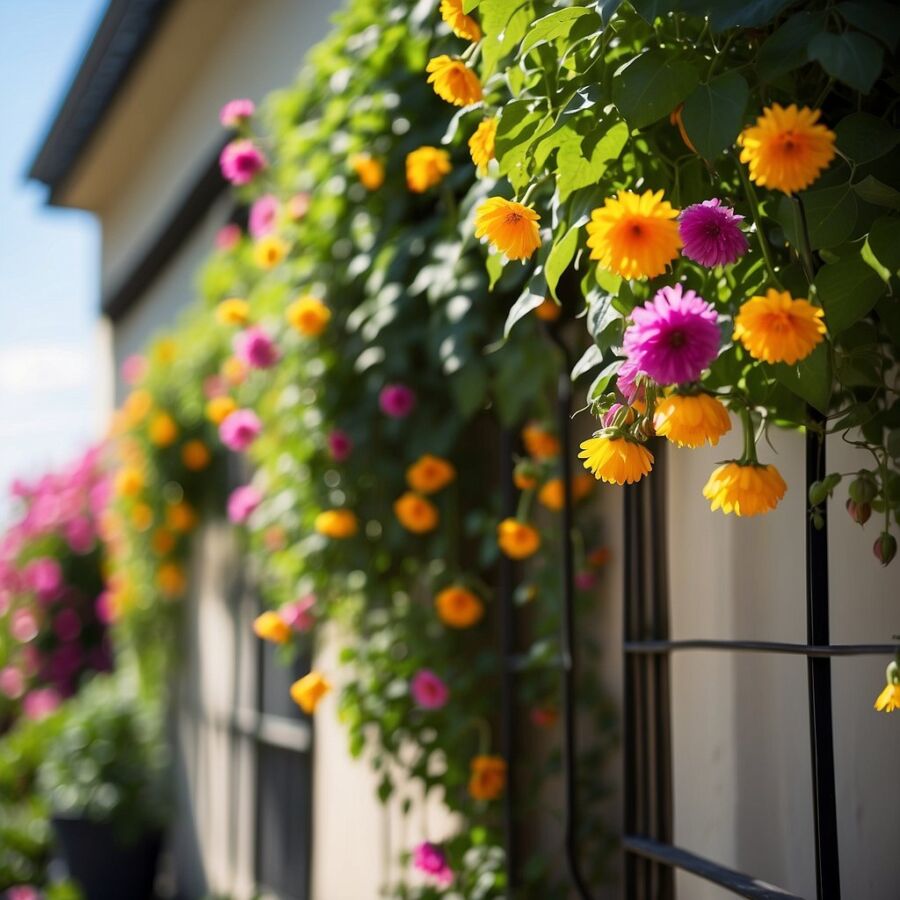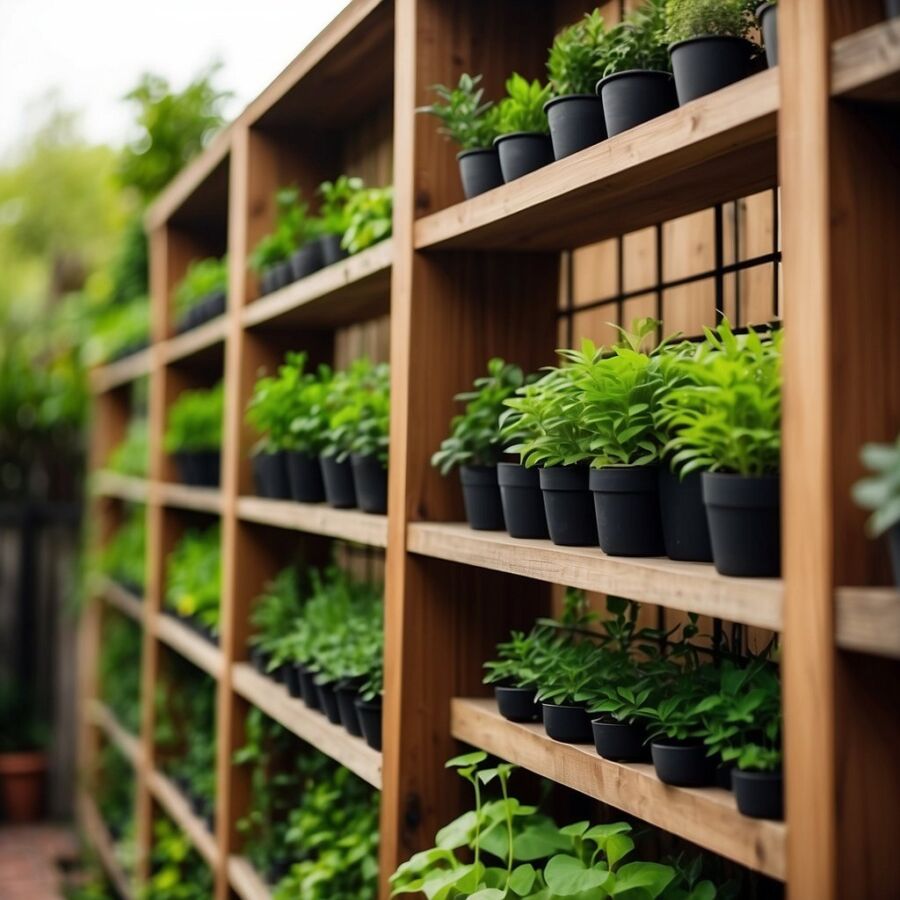Vertical gardening is a method that allows you to grow plants upwards rather than outwards, which is ideal if you have limited ground space. By utilizing vertical space, you can cultivate a variety of plants, from flowers to edibles, in areas such as patios, balconies, and even indoor walls.
Containers supports, and garden structures can transform your gardening experience, enabling you to experiment with new layouts and plant arrangements.

You can bring a touch of greenery to your home with DIY vertical garden ideas that cater to your creative side and living arrangements. A pallet garden can serve as an excellent starting template, allowing you to arrange containers at different levels to create a vibrant mosaic of plants.
Alternatively, repurposing items like shoe organizers or creating a living wall with hanging pots are practical solutions that add a unique aesthetic to your garden space.
Embrace the challenge of vertical gardening by constructing bean teepees for climbing plants or utilizing garden arches for vine crops. These structures maximize your growing area and introduce a new dimension to your garden, offering a practical benefit and a visual appeal. With a vertical garden, you’re not just planting but creating a living art piece that evolves each season.
Understanding Vertical Gardening

Vertical gardening is your innovative solution for making the most out of limited space. You create a lush, green environment on a small-footprint area like a balcony or a narrow backyard by directing plant growth upwards rather than outwards.
Essentials of Vertical Gardening:
- Structures: Employ structures like trellises, hanging baskets, or living wall systems that enable plants to climb or be stacked vertically, offering utility and aesthetic appeal to your space.
- Benefits: Vertical gardens can reduce pest problems and facilitate easier harvesting. They also help insulate your home when applied to exterior walls.
Getting Started:
- Choose a Location: A modestly sized wall or balcony can host a vertical garden. Ensure the spot receives adequate sunlight for the plants you want to grow.
- Select Your Plants: Opt for plants suited to vertical growth. Vine species, such as tomatoes or climbing flowers, are ideal.
DIY Ideas:
- Pallets: Reclaimed pallets can be mounted on a wall with pots or planters attached to the slats.
- Gutters: Recycled gutters can be affixed horizontally and filled with soil for a space-saving salad bar.
Adapting to Your Space:
- For balconies, use rail planters or hanging systems that don’t require floor space.
- Inside, create a living wall to purify the air and introduce a dynamic decor element.
Remember, your imagination is the only limit. Vertical gardens optimize your planting area and add a living, breathing design element to your home. Harness the vertical dimension and transform your space into a green sanctuary.
See Related: How to Create an Apartment Garden?
The Best Plants for Vertical Gardening

Embrace the heights of horticulture by choosing the best plants to enrich your vertical gardening space, turning any small area into a lush and productive green haven. Let’s create your botanical tapestry with various flowers, herbs, succulents, and edibles that thrive in a vertical setting.
Flowers and Herbs
Flowers add bursts of color while herbs infuse your garden with aroma and flavor. To make the most of your vertical space, consider these attractive and practical options:
- Flowers: Opt for climbing varieties like the dynamic Cardinal Climber to coat your trellis in a sea of red blooms.
- Herbs: Vertical gardens are excellent for herbs like basil and thyme, which can grow well in smaller spaces with adequate sunlight.
Vegetables and Fruits
Incorporate edibles into your vertical paradise. Edible plants like vegetables and fruits can be both ornamental and practical in a vertical setup. Here’s what works well:
- Vegetables: Grow climbers like peas and cucumbers up trellises to save ground space and support healthy growth.
- Fruits: Small fruits such as strawberries can be vertically hung, allowing for a bountiful and easy-to-harvest display.
Succulents and Houseplants
These low-maintenance plant choices are perfect for indoor or shaded vertical gardens. Choose plants that need minimal watering and upkeep for a hassle-free garden wall.
- Succulents: Hardy and drought-resistant, many succulents can slot perfectly into vertical planters, creating a tapestry of texture and color.
- Houseplants: Select houseplants like English ivy for their ability to grow in various light conditions, bringing greenery to every corner of your home.
Transform that blank wall or empty fence into a living masterpiece with plants that rise above the ordinary. With creativity and a touch of garden know-how, your vertical haven is just a plant away.
DIY Vertical Garden Ideas

Elevate your gardening game by transforming any small space into a lush oasis. From traditional trellising to innovative upcycling, these DIY vertical garden ideas empower you to create green sanctuaries in even the most space-challenged environments.
Traditional Structures
Trellises and Arbors:
- Trellises: A trellis can be made from wood or metal, ideal for climbing plants like pole beans and vine tomatoes. Create a simple yet effective trellis using bamboo stakes, or build a more durable structure using lumber.
- Arbors and Pergolas: Introduce charm and elegance to your garden with a wooden or metal arbor, perfect for creating an inviting entryway draped with vining plants. A DIY pergola offers a larger area for shade-loving climbers.
Garden Arch and Obelisks:
- Embrace classic garden elements with a self-made garden arch or obelisk. Craft these using bendable materials like willow branches for a rustic look, or go for a more professional finish using metal rods.
Innovative Containers
Upcycled Planters:
- Repurpose old items as innovative vertical planters. Stack and secure old drawers, bins, or buckets to create a tiered planting structure.
- Wall Planters and Hanging Baskets: Mount upcycled items like bottles, cans, or picture frames-turned-planters on your wall. Suspended hanging baskets can beautifully display trailing plants, adding layers of greenery.
Pallet Gardens and Stacked Planters:
- Pallet Garden: Transform a wooden pallet into a vertical garden by adding pockets for soil and securing it against a wall.
- Stacked Planters: Utilize stacking pots or planters to create a cascading vertical effect—optimal for herbs and small flowers.
Creative Plant Supports
Natural and Fabricated Supports:
- Bean Teepees: Craft a bean teepee using bamboo poles for a functional and whimsical feature. Tie the tops together and plant your pole beans around each base.
- A-Frame Structures: Construct an A-frame using wood or metal, perfect for training peas or cucumbers.
Trellising and Training Systems:
- Fan Trellis: Built from wood or metal, spread fan trellises across your wall to support a variety of climbing plants.
- Tower Gardens and Training: Use vertical tower gardens for compact spaces and employ training techniques to guide the upward growth of plants.
These DIY vertical garden structures maximize your growing area and add visual interest to your living space. With creativity and some basic materials, your vertical garden will soon become a thriving focal point of your home.
See Related: Cheap Nursery Pots for Greenhouses & Gardening
Innovative Vertical Gardening Systems

Vertical gardening is a dynamic field that offers innovative systems that maximize your growing space and allow for gardening in smaller areas. These systems bring greenery to urban environments and transform how you cultivate plants at home or professionally.
Integrated Solutions
Integrated vertical gardening systems provide an all-in-one solution, marrying aesthetics with functionality.
Your green walls and archways can become living art; they’re not only visually captivating but also capable of supporting a variety of plant life. For instance, cages and trellises can be seamlessly worked into the façade of a building, serving as a support structure for climbing vegetables.
Additionally, integrating irrigation systems—such as drip irrigation systems—ensures that your vertical gardens vertically remain healthy and hydrated without manual labor.
DIY Idea: Transform a wooden pallet into a rustic vertical garden frame. Attach planters or pots, fill them with raised garden bed soil, and grow herbs or flowers.
Space-Saving Techniques
In smaller spaces, every inch counts. Utilize techniques like hanging planters, stacked raised beds, or repurposing shoe organizers as plant holders to increase your growing space significantly.
Initiatives like converting part of a greenhouse into a series of garden rooms filled with vertical elements save space and create a unique horticultural experience. Even in a small space like a balcony, vertical gardening techniques allow you to enjoy a lush garden.
DIY Tip: Install a simple drip irrigation system to hang planters to minimize water usage while ensuring each plant receives adequate moisture.
By employing these innovative vertical gardening systems, your small spaces are transformed into vibrant ecosystems. Embrace these garden trends and adapt them to suit your lifestyle for a flourishing, space-efficient garden.
See Related: Best Glass Greenhouses in 2023
Tips for Maintaining Your Vertical Garden

For urban dwellers, vertical gardens are a delight, letting you bring lush greenery to apartments and balconies. These gardens offer a space-saving solution while adding a touch of nature’s charm to city living. Here’s how to keep your vertical oasis thriving:
- Watering: Ensure consistent moisture without overwatering. Use a drip irrigation system for uniformity and convenience.
- Soil: Opt for a high-quality potting mix that retains moisture yet drains well to avoid root rot.
- Light: Position your garden so it gets sufficient light; morning sun is ideal, especially for edibles like sage and basil.
- Fertilizing: Feed your plants with the right nutrients. A slow-release fertilizer can work wonders.
- Pruning: Regularly trim annual vines to encourage new growth and maintain appearance. For perennial vines and climbing roses, seasonal pruning is key.
- Weeding: Keep an eye on unwanted growth and remove weeds to prevent competition for nutrients.
- Structures: Choose sturdier structures for heavy plants and ensure they’re secured.
- Pests: Inspect regularly. Introduce beneficial insects or apply organic solutions to keep pests at bay.
| Vegetables | Light Needs | Watering Frequency | Notes |
|---|---|---|---|
| Basil | Full sun to partial shade | Moderate to frequent | Pinch off tips to promote bushiness |
| Sage | Full sun | Moderate | Drought-tolerant; less water required |
Consider plants’ heights and growth habits for tower and container gardens. Mix in florals with edibles for a beautiful and practical display. Remember, your vertical garden is not just a project but a growing, evolving tapestry that reflects your care and creativity.


